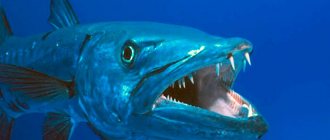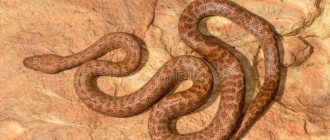The Katran shark, or Black Sea shark, belongs to the cartilaginous fish of the order Katraniformes. The species was first described in 1758 by the scientist Carl Linnaeus. The name is translated from Greek as thorn or thorn, and fishermen often call the individual a short-finned spiny shark. This species is one of the most common and can be found in the waters of most oceans and seas around the world. The animal is of particular interest to the food industry and sport fishing.
The Katran shark, or Black Sea shark, belongs to the cartilaginous fish of the order Katraniformes.
Read more: types of sharks.
Taxonomy and General Characteristics
The Black Sea shark Katran has many names. It's called:
- sand katran;
- southern katran;
- marigold;
- dogfish;
- common katran;
- spotted shark;
- shortfin shark;
- blunt-nosed shark.
All the abundance of these names refers to fish from the order Katraniformes, the family Katranidae, a genus of spiny sharks.
On average, representatives of this formidable tribe reach about a meter in length. The maximum size of a caught specimen was recorded to be just over one and a half meters.
The spiny shark has a streamlined body shape, which allows it to develop great speed. Males are smaller than females. On average, they reach sizes of 60-90 cm. Females are larger - their size ranges from 75-105 cm. Individuals weigh no more than 10 kg.
We also recommend reading:
Do-it-yourself tackle for carp Fish of the trout species: characteristics and fishing Culinary value of sea bass Tasty and healthy hominy made from corn grits
Almost all names of this fish contain the epithet “spiny”. This is due to the fact that there are sharp spines at the base of its dorsal fins. The first spine is shorter than the dorsal fin, the second is slightly longer than the other dorsal fin. This is how the sea dog protects itself from numerous enemies who want to eat it.
Its skin has small placoid scales. The general color is dark gray, sometimes with small white spots. The snout has a typically shark-like pointed shape. The eyes are relatively large, located at an equal distance from the tip of the snout and the first gill slits.
Description and features
Katran is a small species of shark, the length of which reaches a little more than one and a half meters, and the weight of up to 12 kg. Sometimes larger individuals are found. If you compare the katran in the photo with the sturgeon, you can find many similarities.
The structure of the bodies and elongated shapes indicate belonging to the same group. Between the front and rear fins, both have spiny spines, almost reaching the size of the fins. And also the notochord, which is preserved in both throughout their entire lives.
Katran is a good swimmer with a streamlined, slender body. It is considered the most perfect for large fish. It moves quickly in the water due to its tail, which, like an oar, helps balance in the water. The cartilaginous ridge and large fins help to perform oscillatory movements and thereby increase speed.
The body of the katran, ideal for hunting, is covered with hard grayish-brown scales with many sharp teeth. There are almost no bones in the shark's body, there is only a cartilaginous skeleton, which allows it to be agile and nimble. This skeleton also helps to greatly lighten the weight of a marine predator, regardless of age.
Above the eyes there are small filament-branched outgrowths. They are called blades. The shark, like other representatives, has a large pointed mouth in the shape of a crescent and several rows of fang-like teeth. They are single-vertex and arranged in several rows.
They help her, like a good hunter, to instantly deal with prey and are her main weapon. It carefully chews its prey with its numerous teeth, rather than swallowing it whole. Teeth are the only organ that consists of bone. The rest of the body is cartilage and meat.
Katrana is often called the sea dog or spiny shark
The shark does not swallow its prey whole, but carefully chews it with its numerous teeth. The eyes are rather large and look like glass buttons. Has excellent eyesight. It differs from other fish in that it lacks an anal fin and gill covers. Sexual characteristics are weakly expressed; they can only be distinguished by size - the female always looks larger than the male.
The Katran shark is known for not being able to perceive pain at all. It has the ability to detect low frequencies of infrasound and distinguish odors. Thanks to the nasal openings entering the mouth, it can identify the smell of the future victim, which it emits out of fear. The smell of blood can be felt for many kilometers.
The dark color of the back, sides and light color of the belly helps it camouflage itself as the seabed. This makes it almost invisible in the water. Sometimes there are species of gray-metallic color with many dark spots. Easily navigates the water. The sensitive lateral line helps it in this, allowing the fish to feel the slightest fluctuations in the water.
Among sharks, the Katran has the smallest size
Gallery: Katran shark (25 photos)
How many teeth does a shark have?
The shape, size and number of teeth depend on what kind of life the shark leads and what it eats. Teeth are the main weapon of these predators and their growth continues throughout the entire life cycle of the fish. This is nothing more than modified placoid scales covering the skin.
Interesting: The most dangerous marine inhabitants - list, description, photos and videos
Most sharks have teeth growing in several rows - from 3 to 20 on both jaws. Each row contains about 30 teeth. Thus, an adult can have 200-15,000 teeth. However, they do not have roots, so teeth change quite often and unnoticed by the predator itself.
White shark teeth
Diet primarily affects the size and shape of teeth. Most predator sharks have sharp, cone-shaped teeth (about 5 cm long). If fish feed on hard-shelled food, they need flat, crushing teeth. Sharks that hunt large prey have wide and serrated teeth. Fish that feed on plankton have small teeth - only 3-5 mm.
Number of teeth in different types of sharks:
- white and brindle - 5-6 rows, up to 300;
- mustachioed - 5-7 rows, up to 500;
- hammerhead shark – 15-17 rows, up to 700;
- sand tiger - 42-28 rows, up to 1300;
- giant – 6-10 rows, up to 2000;
- whale - 18-20 rows, up to 15,000.
Whale shark mouth
Habitats
The spiny shark is ubiquitous on the continental shelf of the temperate climate zone.
The range is extensive. It can be described as follows:
- Western Atlantic - from the island of Greenland to the coast of Argentina;
- Eastern Atlantic - from Iceland to South Africa;
- Mediterranean Sea;
- Black Sea;
- Pacific Ocean - in the areas of New Guinea, Japan, Korea, Northern China, the Bering and Okhotsk Seas;
- South coast of Australia and New Zealand.
Depending on their habitat, these fish have a number of populations. The Black Sea katran is the only representative of sharks that lives in the European part of the Russian Federation. Those sharks that swim into the Far Eastern seas of Russia belong to a slightly different, albeit related species.
Cartilaginous fish and man
For amateur and professional fishermen, the katran often becomes a real problem, as it damages nets and destroys the catch. In mid-1950, Japan even established a reward for those fishermen who could catch this predator.
Currently, the fish is considered valuable for the food and pharmaceutical industries. It has been established that the liver of the katran fish contains many times more valuable fat than the liver of cod and other fish. This is why the shark is valued. Its meat also has unique taste and beneficial properties for the human body.
Meat is especially valued in Norway, where it is actively consumed, and they also prefer to use katran eggs in cooking, which, according to scientists, contain several times more protein than chicken eggs. However, the consumption of spiny shark products is not so widespread in all countries.
In most countries, its meat is served under the guise of other, more common fish. In addition to valuable fat, it contains many vitamins, for example, a large amount of retinol. This makes the product even more valuable.
Currently, Katran fish is considered valuable for the food and pharmaceutical industries.The cartilage of individuals also becomes useful for humans, from which chondroprotective drugs are made for the treatment of various pathologies of the musculoskeletal system. The fins and heads are also prized because they secrete a sticky substance used to make glue.
The catch of the Black Sea shark is not large-scale, but currently the individual is included in the list of vulnerable animals, which in the coming years may completely disappear or greatly reduce their numbers. This is due to the fact that the gestation period for cubs is quite long, and their number decreases every year.
The Black Sea shark is not dangerous to humans. For many centuries, not a single case is known when these animals attacked a person, although in the Black Sea they quite often intersect with people.
Lifestyle
These sharks, despite their excellent ability to swim quickly and even swiftly, prefer to stay near the bottom. Perhaps this habit occurs due to the fact that they live mainly on the shelf, that is, in waters with shallow depths. For example, in the Black Sea, specimens are found both in the thickness and even at the surface of the water.
These fish are capable of making large seasonal migrations. They gather in large schools. Moreover, flocks are divided by gender and size.
Habitats: coastal zones of the seas. However, there are cases when the katran swims into river estuaries. The change in water salinity does not bother him.
Interesting Facts
Sharks constantly change teeth, replacing lost ones with new ones. Katrans are called monogamous people. They observe long-term monogamy. Each male, after choosing a partner, has the right to impregnate only his own female. It has a large thorn, the cut of which, like a tree, has annual rings that determine its age.
The scales resemble fine sandpaper, but last longer. Sometimes katrans are exterminated in pursuit of their skin, which is used for wood processing. In Canada in the 50s of the last century, the government established rewards for the destruction of this species. The reason was the great damage that was caused to the fishing industry.
Katran was the first shark to be caught for fish oil. They make seasonal migrations that follow strict rules. Sharks form large schools, divided into groups based on gender and size.
When moving, it can develop high speed, but it cannot brake sharply. The most expensive shark food is a delicious soup, which is listed in the Guinness Book of Records. It is cooked from fins. Before attacking the victim, it studies it, making circles around it and will attack if the victim is weaker.
The nutritional value of the liver of the spiny shark is high, which is obtained as an important source of fish oil and vitamins A and D. The percentage of these substances exceeds that of cod species.
In northern countries, they eat katran eggs, which contain more protein than chicken eggs. Oriental gourmets enjoy eating katran meat. You can boil, fry, smoke. They are used to prepare second courses, balyk, canned food, flour, and make shish kebab and steak.
In medicine, cartilage is used to produce medicines for people suffering from diseases of the skeletal system. The sticky substance found in the spines, fins and head bones is used to make glue.
Katran, the shark that is the first to not attack humans
Food preferences
Everyone associates the image of a shark with a stupid and aggressive predator that grabs everything. To some extent this is true. However, there are species that feed on plankton. However, this is rather an exception to the rule.
Katrans are actively included in the food chains of the seas, fortunately the shelf provides them with such an opportunity. They feed mainly on:
- mackerel;
- hake;
- gerbil;
- haddock;
- flounder;
- salmon;
- manhadenem;
- crabs;
- squid;
- octopuses;
- shrimp;
- anemones;
- jellyfish;
- algae.
In turn, this fish is a food supply for larger inhabitants of the oceans and seas. Other sharks and marine mammals, especially killer whales, feed on it. If individuals rise to the surface of the water, they become prey for birds. They are even caught by seagulls, who drag the shark ashore, throwing it onto sharp stones. The carcass is then pecked by birds of different species and sizes.
Nutrition
The Katran shark cannot be called a dangerous predator, but in those areas where its presence is high, it causes great harm to fisheries. Commercial fish are being destroyed. Katran, like all sharks, is very voracious and always hungry.
This is due to the fact that in order to breathe, he needs to constantly be in motion. This consumes a lot of energy, which he replaces with endless food intake. To satisfy its hunger, it hunts small and medium-sized fish that lead a schooling lifestyle. It can be:
- sprats;
- mackerel;
- cod,
- salmon;
- anchovy;
- herring;
- flounder;
- crab;
- seaweed;
- squid;
- anemone.
If there is not enough fish for food, then the spiny shark feeds on: jellyfish, octopuses, shrimp, crabs, and algae. Scientists have discovered that Katrans can also unite in schools to hunt dolphins. The latter become fewer where there is a large population of sharks.
Breeding conditions
The reproduction of these fish is peculiar. They are ovoviviparous. This means that eggs (spawn) are formed, but not laid.
Their mating is internal. This happens in the spring. Eggs are formed in the dilated oviducts, located in two thin gelatinous capsules. This process of gestation of eggs inside the female's body is somewhat similar to pregnancy in birds or mammals. This pregnancy lasts from 18 to 22 months. Juveniles grown in the womb are usually born in the spring. With each litter from 1 female, about 20 fry 22-27 cm long appear.
This method of reproduction protects the young from early death at the egg stage. This increases the fertility of the species, despite the small number of individuals born per litter.
Puberty occurs depending on gender. Males become adults at the age of 11 years, reaching a length of about a meter. Females mature later - at the age of about 20 years with a height of one to one and a half meters. This fish lives for a long time, almost like a person - up to 75 years.
Goblin shark: an unusual guest from the Pacific Ocean
And now a little history. In 2010, in Crimea, off the coast of Sevastopol, local fishermen caught a Goblin shark, which lives in the depths of the Pacific Ocean. Naturally, they were puzzled by such a catch, as a result of which the sensational catch led to investigations into how this creature could get into the waters of the Black Sea, which is located thousands of kilometers away from her home. Here is what is said about this in the expedition reports of the Kharkov researcher of anomalous phenomena Sergei Petrov:
“Sevastopol fishermen were quite surprised when they caught this monster. Many sea reptiles have been seen here, but this is the first time such a specimen has been caught. The footage posted on the Mobile Reporter website shows how the sailors do not know what to do with the catch. A goblin shark, goblin shark, rhinoceros shark or scapanorhynchus (lat. Mitsukurina owstoni) got caught in the fishermen's net. The fish got its name for its bizarre appearance: the shark’s snout ends in a long beak-like outgrowth. This species has been little studied; less than five dozen specimens are known to science.
The brownie lives off the coast of Japan in the waters of the Pacific Ocean, and how it ended up in the Antlantka, where the salinity of the water is different, is unclear. “I know cases when a blue or tiger shark swam, but they swam to the shores of the Bosphorus and went back, for them this barrier of salinity turned out to be insurmountable,” says Alla Korotkova, curator of the Sevastopol Aquarium Foundation. The brownie shark lives at a depth of 200 meters. This species has been studied very little. It is not even known whether it is endangered or aggressive towards humans.
Read Castmaster with your own hands
For Sevastopol oceanologists it is now a mystery how long the goblin shark lived in the Black Sea. But whether this marine inhabitant was the only representative of its genus in the Sevastopol Bay is unknown. These sharks feed on a variety of organisms that live in deep waters. They eat fish, including other sharks, and can reach lengths of 3-4 meters (there may be larger sharks of this species, but the longest goblin shark discovered was 3.8 meters long). They also feed on crustaceans and squid, octopus and cuttlefish.
The goblin has several rows of teeth, some of which are used for catching prey, while others are used for cracking the shells of crustaceans. The front teeth are long and smoothly framed, while the rear teeth are adapted for gnawing. Up to 25% of the goblin shark's body weight is its liver. This contributes to the buoyancy of the shark, which, like all sharks, lacks a swim bladder.
These sharks hunt, sensing the presence of prey thanks to special sensitive organs; their vision is weak due to the lack of light at great depths. Once the shark finds its prey, it suddenly shoots out its jaws, using a tongue-like muscle to grab the prey with its sharp front teeth."
Use in cooking
This fish is considered a commercial fish and is in great demand in many countries. The fishery is especially developed in Japan, China, Norway, and Great Britain.
Its meat is considered nutritious. It contains 142 kcal, 20% protein, 7% fat, but no carbohydrates at all.
At the same time, fish meat contains: cobalt, sulfur, iodine, potassium, chromium, phosphorus. Of the biologically active substances, the product is rich in retinol, niacin, and tocopherol.
In addition to meat, they also eat liver and cartilage, which are considered delicacies. In addition, it is believed that they contain substances that improve human health. In particular, they improve hematopoiesis, reduce the intensity of inflammatory processes, and activate the immune system.
Katrana can be salted, dried, smoked, fried, boiled. The famous soup is prepared from the fins of this particular shark.
A fat called squalene is rendered from the liver. It is considered the lightest of all animal fats. It contains large amounts of vitamins A and D. It is used in medicine and is also used for technical purposes. Ointments are made from shark oil and used to treat joints.
Fins are used not only in cooking, but in medicine and even for technical purposes. For example, shark cartilage and skin are used to make tools that have abrasive properties. In addition, glue is made from fins and cartilage, and pepsin is produced from stomach tissue.
In addition to the delicious shark fin soup, smoked balyki, which are not inferior in taste to the famous smoked eel, are especially valued.
An intermediate product of smoked balyk is salted katran meat.
To prepare it, a large carcass is cut into pieces of the required size. They are cleaned, washed and immersed in a saline solution for two hours. After this, the pieces are washed. They can be eaten immediately or smoked.
Stewed katran is prepared as follows. Pour a small layer of vegetable oil onto the bottom of the saucepan in an amount sufficient to cover the bottom with oil.
You need to remove the skin from the fish, cut the meat into cubes or thin slices (as you like), and place it on the bottom. Place a layer of onion, cut into slices, on top, then again you need to place pieces of fish, and onion on them. If desired, you can place a layer of grated carrots on top of the fur coat. All this needs to be salted, peppered, sprinkled with spices, brought to a boil and simmered over low heat for 30 minutes without stirring. When everything is ready, you need to add chopped herbs on top. You can add apple cider vinegar or lemon juice to the onion layer.
Natural enemies of katrans
Photo: What does katran look like?
Adult Katrans can only be threatened by killer whales and larger sharks: both of them are not averse to snacking on them. In confrontation with them, the katrans have nothing to count on; they can only injure killer whales, and even then quite weakly: their teeth are too small for these giants.
Getting into fights with larger sharks is also a disastrous proposition for katrans. Therefore, when meeting them, as well as killer whales, all that remains is to turn around and try to hide - fortunately, speed and endurance allow you to count on a successful escape. But you can’t hesitate to do this—you just have to hesitate, and you could end up in the teeth of a shark.
Therefore, katrans are always vigilant, even when they are resting, and are ready to run. They are in greatest danger when they themselves are hunting - their attention is focused on the prey, and they may not notice how a predator swims up to them and prepares to attack.
Another threat is humans. Katran meat is highly valued; balyk and canned food are produced from it, and therefore they are caught on an industrial scale. Every year, people catch millions of individuals: most likely this is much more than killed by killer whales and all sharks combined.
But in general, it cannot be said that an adult katran faces many dangers, and most of them successfully live for several decades: however, only if they manage to survive the first years of life, because they are much more dangerous. Medium-sized predatory fish, as well as birds and marine mammals can prey on fry and young dogfish.
Gradually, as the threats grow, there are fewer and fewer threats, but the katran itself turns into an increasingly formidable predator, exterminating even some of the animals that threatened it earlier - thus, predatory fish suffer from it.
Interesting fact: Although katran meat is tasty, you should not get too carried away with it, and it is better for small children and pregnant women not to eat it at all. There are simply too many heavy metals in it, and too much of them is harmful to the body.
Population and species status
According to recent data, about 25% of all shark species are on the verge of extinction. The total number of fish is declining at a fairly high rate. There are several reasons for this:
- Low reproductive capacity - sharks focus on the quality of the offspring produced, not the quantity. That is why, of all the cubs, only a few of the strongest remain.
- Shark fishing, in particular, is illegal.
- Reducing the amount of food that predators eat. This includes a decline in the number of mammals.
- Pollution of the World Ocean waters with waste. This is especially true for plastic.
Garbage continents (the Great Pacific Garbage Patch is highlighted in red)
It is worth noting that sharks, especially hungry ones, tend to consume everything in their path. That's why they are attracted to large piles of garbage floating in the ocean - they create vibrations. Sharks are also quite curious.
Keeping sharks in captivity
Only a few species of sharks can be found in captivity. Known or, conversely, rare species are of greatest interest. As a rule, they are distinguished by their large size and aggressive behavior. It is quite difficult to catch such sharks, as well as transport them. It is important not to damage them.
Whale shark in the aquarium
Specialists will also face difficulties when relocating an individual to an artificial tank. It must be spacious and durable enough, contain all the necessary equipment so that the shark feels safe. Support for normal functioning is required.
Interesting: 10 most beautiful fish on the planet - list, names, photos and videos
How long do sharks live?
The average lifespan of most sharks is about 30 years. However, there are also long-lived species. These include whale sharks, spotted spiny sharks, and Greenland polar sharks, which can live up to 100 years. It is the Greenland polar shark that is considered the record holder in terms of longevity. For example, the age of one of them would be estimated by scientists at 392 years with an error of 100 years. On average, the species lives up to 272 years.
Interesting fact : in 2022, scientists discovered the oldest and at the same time the largest shark, a representative of the Greenland polar species. Estimated age is about 500 years. The fact is that over the course of a year, sharks of this species grow 1 cm in length. And the length of this individual was 5.4 m.
Greenland shark
Longevity is directly related to a shark's teeth, because if a predator loses its main weapon, it will not be able to feed.
Shark fishing
More than 100 species of sharks are fished, as are many other fish. The fishing industry is interested in shark meat, fins, cartilage, liver and skin. Fishing is most active in the Atlantic Ocean, followed by the Indian and Pacific Oceans.
Up to 100 million individuals are caught every year. Bans and restrictions on fishing are gradually being introduced, but its intensity is only increasing. Sharks are caught not only as a target fishery, but also accidentally - during the catch of other fish.
Shark and diver
There is a separate type of fishing - shark fin fishing. It is banned in some countries. Other reasons for catching sharks include increased danger on beaches and the threat of a decline in the population of other fish species.
Fish or mammal?
The term "mammal" refers to feeding its young with milk. Sharks do not do this, so they are clearly classified as fish. In addition, they breathe using gills.
Many sharks are comparable in size to large marine mammals, such as some species of whales. However, this does not give reason to classify them in this category.
Comparison of the sizes of whales and white sharks
The appearance of some shark species can also be misleading. For example, the frilled shark looks like an eel, the carpet shark lives on the bottom, and the hammerhead shark is easily recognizable by its characteristic head shape.
Interesting fact : an unusual representative of sharks, the carpet shark, has an extraordinary appearance, swims poorly and most of the time lies on the bottom waiting for fish to swim by.
Behavior and lifestyle
It is believed that sharks prefer to lead a solitary lifestyle and not form schools. However, from time to time they can be seen in groups, and quite large ones at that. Most often these are places with abundant food. Sharks also live in groups during reproduction.
Certain species of sharks prefer not to change their usual habitat. Others migrate, covering distances of thousands of kilometers. The migration system of fish is much more complex than that of birds. There is also a hierarchical system among sharks, according to which some species are subordinate to others. For example, despite the same size, the silky shark is subordinate to the white shark.
Sharks do not always attack immediately as soon as they see an enemy. They communicate through movements. If an unwanted object approaches, the predator can give a threatening signal by moving its fins more intensely.
School of hammerhead sharks
The average speed of sharks is about 8 km/h. If necessary, this figure can increase to 19 km/h. Some species (white shark, etc.) make high-speed bursts of about 50 km/h. This ability is inherent in them due to the previously mentioned temperature difference.
According to new research, sharks are capable of displaying playfulness, curiosity, intelligence and other signs of intelligence. They often overcome difficulties as part of a group.
How do sharks sleep?
For a long time it was believed that sharks cannot sleep because they need to constantly move to obtain oxygen. However, experts say that at least some species of sharks (demersal) can remain dormant for some time.
Interesting fact : only some sharks can remain stationary for a long time (during sleep), for example, the whiskered nurse shark. At the same time, they pump water through their gills and receive oxygen.
Whiskered nurse shark resting on the bottom
When sleeping on the bottom, sharks do not close their eyes or use their nostrils. However, they may involve squirters. Some species can sleep while moving because their spinal cord is responsible for movement. Another theory is the ability to turn off the hemispheres of the brain in turn.
Sharks can also “take a break” in underwater caves, where there is a fairly strong current. Interestingly, in one of these caves, scuba divers discovered Caribbean reef sharks. They appeared to be sleeping, despite the fact that this species is an active swimmer.
How and what do sharks drink?
Strictly speaking, sharks do not need to regularly drink water in the strictest sense of the word. Being in salt water, they absorb it constantly, and through the walls of the stomach the fresh component is absorbed into the blood and spread throughout the body.
At the same time, the fluid in the shark's body contains less salts than the water in the environment. A physical process called osmotic pressure occurs - a liquid with a lower concentration of salts rushes towards a liquid with a higher concentration. They contact through the skin of the fish. Thus, the sharks’ body gets rid of excess salt.
Interesting fact : sharks, which are able to live in both salt and fresh water (or only fresh), have the unique ability to adapt their body to life in a certain environment. For example, a blunt-nosed shark.
The largest sharks in the world
Species of sharks that are particularly large in size:
- Megalodon is a long-extinct species, but according to the teeth found, the length was about 15 m, weight up to 40,000 kg.
- Large whale shark - length 12 m or more, weight 21,000 kg.
- Giant shark - length 9-10 m, weight 4000 kg.
- Tiger shark - length 7.5 m, weight 939 kg.
- Great white shark - length 6 m, weight 1500 kg.
- Greenland shark – length 4-6, weight 1020 kg.
- Hammerhead shark - length 5-6 meters, weight 844 kg.
Megalodon and white shark teeth
Sharks in culture
Sharks, as unique and interesting creatures, could not help but become part of the culture for many peoples of the world. At a minimum, everyone has probably seen Western films in which sharks act as real monsters.
But this is not the entire role of fish in cultural heritage. They are mentioned in Greek mythology, Japanese, Polynesian culture. In particular, for the inhabitants of the Hawaiian Islands, sharks are not dangerous predators, but sea guardians who protect the local people.
Australian aborigines regard them as gifts of nature intended for humans. The Chinese consider sharks as a fishery, namely, they are considered valuable in the field of food industry and traditional medicine.
In popular culture, a shark is an essential element of a horror film or thriller about sea monsters. Examples of films featuring predator sharks:
- "Jaws" (1975);
- "The Abyss" (1977);
- "Deep Blue Sea" (1999);
- “The Shallows” (2016), etc.











